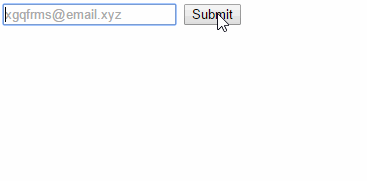Set custom HTML5 required field validation message
JavascriptJqueryHtmlJavascript Problem Overview
Required field custom validation
I have one form with many input fields. I have put html5 validations
<input type="text" name="topicName" id="topicName" required />
when I submit the form without filling this textbox it shows default message like
"Please fill out this field"
Can anyone please help me to edit this message?
I have a javascript code to edit it, but it's not working
$(document).ready(function() {
var elements = document.getElementsByName("topicName");
for (var i = 0; i < elements.length; i++) {
elements[i].oninvalid = function(e) {
e.target.setCustomValidity("");
if (!e.target.validity.valid) {
e.target.setCustomValidity("Please enter Room Topic Title");
}
};
elements[i].oninput = function(e) {
e.target.setCustomValidity("");
};
}
})
Email custom validations
I have following HTML form
<form id="myform">
<input id="email" name="email" type="email" />
<input type="submit" />
</form>
Validation messages I want like.
Required field: Please Enter Email Address
Wrong Email: '[email protected]' is not a Valid Email Address. (here, entered email address displayed in textbox)
I have tried this.
function check(input) {
if(input.validity.typeMismatch){
input.setCustomValidity("'" + input.value + "' is not a Valid Email Address.");
}
else {
input.setCustomValidity("");
}
}
This function is not working properly, Do you have any other way to do this? It would be appreciated.
Javascript Solutions
Solution 1 - Javascript
Code snippet
Since this answer got very much attention, here is a nice configurable snippet I came up with:
/**
* @author ComFreek <https://stackoverflow.com/users/603003/comfreek>
* @link https://stackoverflow.com/a/16069817/603003
* @license MIT 2013-2015 ComFreek
* @license[dual licensed] CC BY-SA 3.0 2013-2015 ComFreek
* You MUST retain this license header!
*/
(function (exports) {
function valOrFunction(val, ctx, args) {
if (typeof val == "function") {
return val.apply(ctx, args);
} else {
return val;
}
}
function InvalidInputHelper(input, options) {
input.setCustomValidity(valOrFunction(options.defaultText, window, [input]));
function changeOrInput() {
if (input.value == "") {
input.setCustomValidity(valOrFunction(options.emptyText, window, [input]));
} else {
input.setCustomValidity("");
}
}
function invalid() {
if (input.value == "") {
input.setCustomValidity(valOrFunction(options.emptyText, window, [input]));
} else {
input.setCustomValidity(valOrFunction(options.invalidText, window, [input]));
}
}
input.addEventListener("change", changeOrInput);
input.addEventListener("input", changeOrInput);
input.addEventListener("invalid", invalid);
}
exports.InvalidInputHelper = InvalidInputHelper;
})(window);
Usage
→ jsFiddle
<input id="email" type="email" required="required" />
InvalidInputHelper(document.getElementById("email"), {
defaultText: "Please enter an email address!",
emptyText: "Please enter an email address!",
invalidText: function (input) {
return 'The email address "' + input.value + '" is invalid!';
}
});
More details
defaultTextis displayed initiallyemptyTextis displayed when the input is empty (was cleared)invalidTextis displayed when the input is marked as invalid by the browser (for example when it's not a valid email address)
You can either assign a string or a function to each of the three properties.
If you assign a function, it can accept a reference to the input element (DOM node) and it must return a string which is then displayed as the error message.
Compatibility
Tested in:
- Chrome Canary 47.0.2
- IE 11
- Microsoft Edge (using the up-to-date version as of 28/08/2015)
- Firefox 40.0.3
- Opera 31.0
Old answer
You can see the old revision here: https://stackoverflow.com/revisions/16069817/6
Solution 2 - Javascript
You can simply achieve this using oninvalid attribute, checkout this demo code
<form>
<input type="email" pattern="[^@]*@[^@]" required oninvalid="this.setCustomValidity('Put here custom message')"/>
<input type="submit"/>
</form>

Codepen Demo: https://codepen.io/akshaykhale1992/pen/yLNvOqP
Solution 3 - Javascript
HTML:
<form id="myform">
<input id="email" oninvalid="InvalidMsg(this);" name="email" oninput="InvalidMsg(this);" type="email" required="required" />
<input type="submit" />
</form>
JAVASCRIPT :
function InvalidMsg(textbox) {
if (textbox.value == '') {
textbox.setCustomValidity('Required email address');
}
else if (textbox.validity.typeMismatch){{
textbox.setCustomValidity('please enter a valid email address');
}
else {
textbox.setCustomValidity('');
}
return true;
}
Demo :
Solution 4 - Javascript
Try this:
$(function() {
var elements = document.getElementsByName("topicName");
for (var i = 0; i < elements.length; i++) {
elements[i].oninvalid = function(e) {
e.target.setCustomValidity("Please enter Room Topic Title");
};
}
})
I tested this in Chrome and FF and it worked in both browsers.
Solution 5 - Javascript
Man, I never have done that in HTML 5 but I'll try. Take a look on this fiddle.
I have used some jQuery, HTML5 native events and properties and a custom attribute on input tag(this may cause problem if you try to validade your code). I didn't tested in all browsers but I think it may work.
This is the field validation JavaScript code with jQuery:
$(document).ready(function()
{
$('input[required], input[required="required"]').each(function(i, e)
{
e.oninput = function(el)
{
el.target.setCustomValidity("");
if (el.target.type == "email")
{
if (el.target.validity.patternMismatch)
{
el.target.setCustomValidity("E-mail format invalid.");
if (el.target.validity.typeMismatch)
{
el.target.setCustomValidity("An e-mail address must be given.");
}
}
}
};
e.oninvalid = function(el)
{
el.target.setCustomValidity(!el.target.validity.valid ? e.attributes.requiredmessage.value : "");
};
});
});
Nice. Here is the simple form html:
<form method="post" action="" id="validation">
<input type="text" id="name" name="name" required="required" requiredmessage="Name is required." />
<input type="email" id="email" name="email" required="required" requiredmessage="A valid E-mail address is required." pattern="^[a-zA-Z0-9_.-]+@[a-zA-Z0-9-]+.[a-zA-Z0-9]+$" />
<input type="submit" value="Send it!" />
</form>
The attribute requiredmessage is the custom attribute I talked about. You can set your message for each required field there cause jQuery will get from it when it will display the error message. You don't have to set each field right on JavaScript, jQuery does it for you. That regex seems to be fine(at least it block your [email protected]! haha)
As you can see on fiddle, I make an extra validation of submit form event(this goes on document.ready too):
$("#validation").on("submit", function(e)
{
for (var i = 0; i < e.target.length; i++)
{
if (!e.target[i].validity.valid)
{
window.alert(e.target.attributes.requiredmessage.value);
e.target.focus();
return false;
}
}
});
I hope this works or helps you in anyway.
Solution 6 - Javascript
This works well for me:
jQuery(document).ready(function($) {
var intputElements = document.getElementsByTagName("INPUT");
for (var i = 0; i < intputElements.length; i++) {
intputElements[i].oninvalid = function (e) {
e.target.setCustomValidity("");
if (!e.target.validity.valid) {
if (e.target.name == "email") {
e.target.setCustomValidity("Please enter a valid email address.");
} else {
e.target.setCustomValidity("Please enter a password.");
}
}
}
}
});
and the form I'm using it with (truncated):
<form id="welcome-popup-form" action="authentication" method="POST">
<input type="hidden" name="signup" value="1">
<input type="email" name="email" id="welcome-email" placeholder="Email" required></div>
<input type="password" name="passwd" id="welcome-passwd" placeholder="Password" required>
<input type="submit" id="submitSignup" name="signup" value="SUBMIT" />
</form>

Solution 7 - Javascript
You can do this setting up an event listener for the 'invalid' across all the inputs of the same type, or just one, depending on what you need, and then setting up the proper message.
[].forEach.call( document.querySelectorAll('[type="email"]'), function(emailElement) {
emailElement.addEventListener('invalid', function() {
var message = this.value + 'is not a valid email address';
emailElement.setCustomValidity(message)
}, false);
emailElement.addEventListener('input', function() {
try{emailElement.setCustomValidity('')}catch(e){}
}, false);
});
The second piece of the script, the validity message will be reset, since otherwise won't be possible to submit the form: for example this prevent the message to be triggered even when the email address has been corrected.
Also you don't have to set up the input field as required, since the 'invalid' will be triggered once you start typing in the input.
Here is a fiddle for that: http://jsfiddle.net/napy84/U4pB7/2/ Hope that helps!
Solution 8 - Javascript
Use the attribute "title" in every input tag and write a message on it
Solution 9 - Javascript
Just need to get the element and use the method setCustomValidity.
Example
var foo = document.getElementById('foo');
foo.setCustomValidity(' An error occurred');
Solution 10 - Javascript
you can just simply using the oninvalid=" attribute, with the bingding the this.setCustomValidity() eventListener!
Here is my demo codes!(you can run it to check out!)

<!DOCTYPE html>
<html lang="en">
<head>
<meta charset="UTF-8">
<title>oninvalid</title>
</head>
<body>
<form action="https://www.google.com.hk/webhp?#safe=strict&q=" method="post" >
<input type="email" placeholder="[email protected]" required="" autocomplete="" autofocus="" oninvalid="this.setCustomValidity(`This is a customlised invalid warning info!`)">
<input type="submit" value="Submit">
</form>
</body>
</html>
reference link
http://caniuse.com/#feat=form-validation
https://www.w3.org/TR/html51/sec-forms.html#sec-constraint-validation
Solution 11 - Javascript
You can add this script for showing your own message.
<script>
input = document.getElementById("topicName");
input.addEventListener('invalid', function (e) {
if(input.validity.valueMissing)
{
e.target.setCustomValidity("Please enter topic name");
}
//To Remove the sticky error message at end write
input.addEventListener('input', function (e) {
e.target.setCustomValidity('');
});
});
</script>
For other validation like pattern mismatch you can add addtional if else condition
like
else if (input.validity.patternMismatch)
{
e.target.setCustomValidity("Your Message");
}
there are other validity conditions like rangeOverflow,rangeUnderflow,stepMismatch,typeMismatch,valid